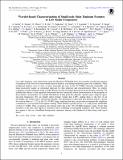Wavelet-based Characterization of Small-scale Solar Emission Features at Low Radio Frequencies
Author(s)
Suresh, A.; Sharma, R.; Oberoi, D.; Das, S. B.; Timar, B.; Bowman, J. D.; Briggs, F.; Deshpande, A. A.; Emrich, D.; Goeke, R.; Greenhill, L. J.; Hazelton, B. J.; Johnston-Hollitt, M.; Kaplan, D. L.; Kasper, J. C.; Lynch, M. J.; Mitchell, D. A.; Morales, M. F.; Ord, S. M.; Prabu, T.; Rogers, A. E. E.; Roshi, A.; Shankar, N. Udaya; Srivani, K. S.; Subrahmanyan, R.; Tingay, S. J.; Waterson, M.; Wayth, R. B.; Webster, R. L.; Whitney, A. R.; Williams, A.; Pankratius, Victor; Lonsdale, Colin John; Cappallo, Roger J; Corey, Brian E; Kratzenberg, Eric W; McWhirter, Stephen R.; Morgan, Edward H; Williams, Christopher Leigh; ... Show more Show less
DownloadSuresh_2017_ApJ_843_19.pdf (1.803Mb)
PUBLISHER_POLICY
Publisher Policy
Article is made available in accordance with the publisher's policy and may be subject to US copyright law. Please refer to the publisher's site for terms of use.
Terms of use
Metadata
Show full item recordAbstract
Low radio frequency solar observations using the Murchison Widefield Array have recently revealed the presence of numerous weak short-lived narrowband emission features, even during moderately quiet solar conditions. These nonthermal features occur at rates of many thousands per hour in the 30.72 MHz observing bandwidth, and hence necessarily require an automated approach for their detection and characterization. Here, we employ continuous wavelet transform using a mother Ricker wavelet for feature detection from the dynamic spectrum. We establish the efficacy of this approach and present the first statistically robust characterization of the properties of these features. In particular, we examine distributions of their peak flux densities, spectral spans, temporal spans, and peak frequencies. We can reliably detect features weaker than 1 SFU, making them, to the best of our knowledge, the weakest bursts reported in literature. The distribution of their peak flux densities follows a power law with an index of -2.23 in the 12-155 SFU range, implying that they can provide an energetically significant contribution to coronal and chromospheric heating. These features typically last for 1-2 s and possess bandwidths of about 4-5 MHz. Their occurrence rate remains fairly flat in the 140-210 MHz frequency range. At the time resolution of the data, they appear as stationary bursts, exhibiting no perceptible frequency drift. These features also appear to ride on a broadband background continuum, hinting at the likelihood of them being weak type-I bursts.
Date issued
2017-06Department
Haystack Observatory; Massachusetts Institute of Technology. Department of Physics; MIT Kavli Institute for Astrophysics and Space ResearchJournal
Astrophysical Journal
Citation
Suresh, A. et al. “Wavelet-Based Characterization of Small-Scale Solar Emission Features at Low Radio Frequencies.” The Astrophysical Journal 843, 1 (June 2017): 19 © 2017 The American Astronomical Society
Version: Final published version
ISSN
1538-4357
0004-637X